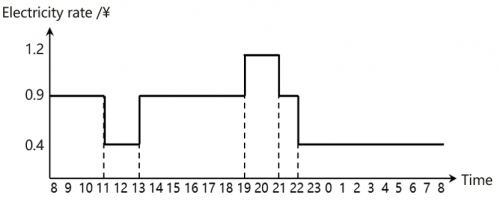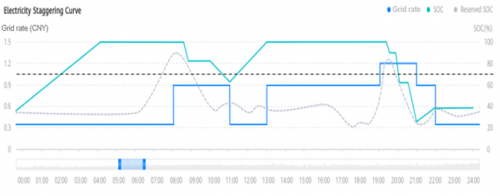Intelligent Peak Staggering Maximizes Site Battery Value, Reducing Electricity Cost by 17.1%
As the deployment of 5G continues, the energy consumption of base stations increased significantly and the number of base stations soars. These lead to a sharp increase in operational expenditure (OPEX). Accounting for about 26% of the OPEX, electricity costs bring great challenges to operators. Therefore, new technologies and solutions are urgently needed to reduce the electricity fees of base stations.
Batteries in traditional solutions are used only for emergency backup and have not become a production tool. Instead, they are idle assets not fully utilized. There is a peak-valley electricity rate in many countries (like China, Portugal and so on) to balance the load power of the electricity network. Huawei’s intelligent peak staggering can be used in this scenario to improve battery utilization efficiency and save electricity costs. The mechanism of peak staggering is charging the battery during valley rate periods and let the battery discharge (not use grid) during peak rate periods. It can also ensure the safe and stable operation of power grids.

Electricity rate in China, Zhejiang
Challenges facing peak staggering
One important function of batteries is providing backup power when gird fails. Peak staggering needs to ensure power backup reliability and battery asset safety. The two factors are usually affected by mains outage, load power fluctuation, battery capacity, and mixed-use of new and old batteries.
The load power of different sites varies and is changing at different times, especially in 5G sites. The state of capacity (SOC) and state of health (SOH) of batteries at different sites are different and changing in different time. Therefore, manual data analysis and calculation are difficult to implement, and accurate parameter settings cannot be provided. If a fixed peak staggering model is used, site breakdown and insufficient backup power may occur due to battery overdischarge, electricity cost saving may be cut due to battery underdischarge.
Principles of intelligent peak staggering
To address these challenges, Huawei uses AI technologies to make peak staggering strategy for high backup reliability and maximum cost saving. Huawei power management system NetEco uses AI to forecast load power and calculate required battery backup capacity. Then reserving battery capacity for backup and using remaining battery capacity for peak staggering. AI-based power outage models, load models and battery models are continuously trained based on big data. Huawei solution can realizes multiple flexible peak staggering policies, including one-site one-policy and one-time one-policy. It means the peak staggering policies of different sites are different.
AI technologies are applied to make optimal peak staggering strategies to improve backup reliability and maximum cost saving. Users do not need to configure peak staggering strategies for sites, different peak staggering strategies of all sites are made by an intelligent management system.
backup power depths for different sites and design charge and discharge policies by themselves.
Value analysis, peak staggering reduce 17.1% electricity cost
China Tower Zhejiang Branch has used intelligent peak staggering for one year. The average revenue is CNY1784/site/year with an average revenue rate of 17.1%, which are profitable. Intelligent peak staggering help Zhejiang Tower release battery potential value. Batteries discharge during peak grid rate duration to save electricity cost. No site breakdown occurred and the reliability of site power supply and backup was effectively ensured.

Peak staggering interface
AI forecast accuracy of load power in Zhejiang Tower sites is very high which ensure the backup reliability of intelligent peak staggering. In scenarios where the load fluctuation is small, such as welfare homes, the average error of load power prediction accuracy is 1.1%. At the same time, the optimal charge and discharge capacity and time are obtained by optimizing the charge and discharge policies, which maximizes energy-saving benefits while maintaining system reliability. The system automatically switches to intermittent discharge and controls temperature rise, prolonging battery service life. In sites with large and random load fluctuation, such as highway exit sites, the average error of load prediction is 5.7%.In scenarios such as commercial buildings, battery backup security is preferred. If the system detects that the backup time is insufficient, it will not trigger peak staggering, ensuring reliable power backup first.
This section briefly analyzes and demonstrates the principles and feasibility of applying intelligent peak staggering to the base station energy storage system. This research can help to cover the disadvantages of the fixed peak staggering solution in 5G evolution, improve the backup power reliability of telecom base stations and maximize the benefits of peak staggering.
Digital and intelligent technologies enhance comprehensive energy scheduling and management for telecom base stations, help realize optimal site-level and network-level energy utilization
Against the background of the 3060 goals (peak carbon dioxide emissions by 2030 and carbon neutrality by 2060), operators are expected to actively pilot and promote the application of AI technologies in telecom base stations. This research helps operators reduce costs, improve efficiency, and transform base station energy architectures. It is a preliminary practice of base station energy scheduling optimization theory in the industry, providing important theoretical and technical support for energy digitalization in more fields.
Disclaimer
The GSM Association (“Association”) makes no representation, warranty or undertaking (express or implied) with respect to and does not accept any responsibility for, and hereby disclaims liability for the accuracy or completeness or timeliness of the information contained in this document.
